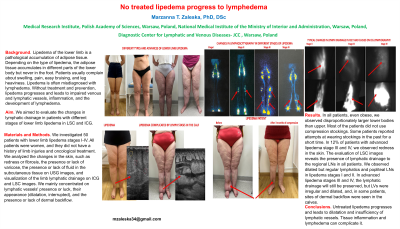Clinical Research
(CR-087) No Treated Lipedema Progress to Lymphedema
Friday, May 2, 2025
7:45 PM - 8:45 PM East Coast USA Time

Natalia Krzesniak, PhD
Introduction: Lipedema of the lower limb is a pathological accumulation of adipose tissue. Depending on the type of lipedema, the adipose tissue accumulates in different parts of the lower body but never in the foot. Patients usually complain about swelling, pain, easy bruising, and leg heaviness. Lipedema is often misdiagnosed with lymphedema. Without treatment and prevention, lipedema progresses and leads to impaired venous and lymphatic vessels, inflammation, and the development of lymphedema.
Aim.
We aimed to evaluate the changes in lymphatic drainage in patients with different stages of lower limb lipedema in LSC and ICG.
Methods: We investigated 50 patients with lower limb lipedema stages I-IV. All patients were women, and they did not have a history of limb injuries and oncological treatment. We analyzed the changes in the skin, such as redness or fibrosis, the presence or lack of varicose, the presence or lack of fluid in the subcutaneous tissue on USG images, and visualization of the limb lymphatic drainage on ICG and LSC images. We mainly concentrated on lymphatic vessels' presence or luck, their appearance (dilatation, interrupted), and the presence or lack of dermal backflow.
Results: In all patients, even obese, we observed disproportionately larger lower bodies than upper. Most of the patients did not use compression stockings. Some patients reported attempts at wearing stockings in the past for a short time. In 12% of patients with advanced lipedema stage III and IV, we observed redness in the skin. The evaluation of LSC images reveals the presence of lymphatic drainage to the regional LNs in all patients. We observed dilated but regular lymphatics and popliteal LNs in lipedema stages I and II. In advanced lipedema stages III and IV, the lymphatic drainage will still be preserved, but LVs were irregular and dilated, and, in some patients, sites of dermal backflow were seen in the calves.
Discussion: Untreated lipedema progresses and leads to dilatation and insufficiency of lymphatic vessels. Tissue inflammation and lymphedema can complicate it.
Aim.
We aimed to evaluate the changes in lymphatic drainage in patients with different stages of lower limb lipedema in LSC and ICG.
Methods: We investigated 50 patients with lower limb lipedema stages I-IV. All patients were women, and they did not have a history of limb injuries and oncological treatment. We analyzed the changes in the skin, such as redness or fibrosis, the presence or lack of varicose, the presence or lack of fluid in the subcutaneous tissue on USG images, and visualization of the limb lymphatic drainage on ICG and LSC images. We mainly concentrated on lymphatic vessels' presence or luck, their appearance (dilatation, interrupted), and the presence or lack of dermal backflow.
Results: In all patients, even obese, we observed disproportionately larger lower bodies than upper. Most of the patients did not use compression stockings. Some patients reported attempts at wearing stockings in the past for a short time. In 12% of patients with advanced lipedema stage III and IV, we observed redness in the skin. The evaluation of LSC images reveals the presence of lymphatic drainage to the regional LNs in all patients. We observed dilated but regular lymphatics and popliteal LNs in lipedema stages I and II. In advanced lipedema stages III and IV, the lymphatic drainage will still be preserved, but LVs were irregular and dilated, and, in some patients, sites of dermal backflow were seen in the calves.
Discussion: Untreated lipedema progresses and leads to dilatation and insufficiency of lymphatic vessels. Tissue inflammation and lymphedema can complicate it.

.jpg)